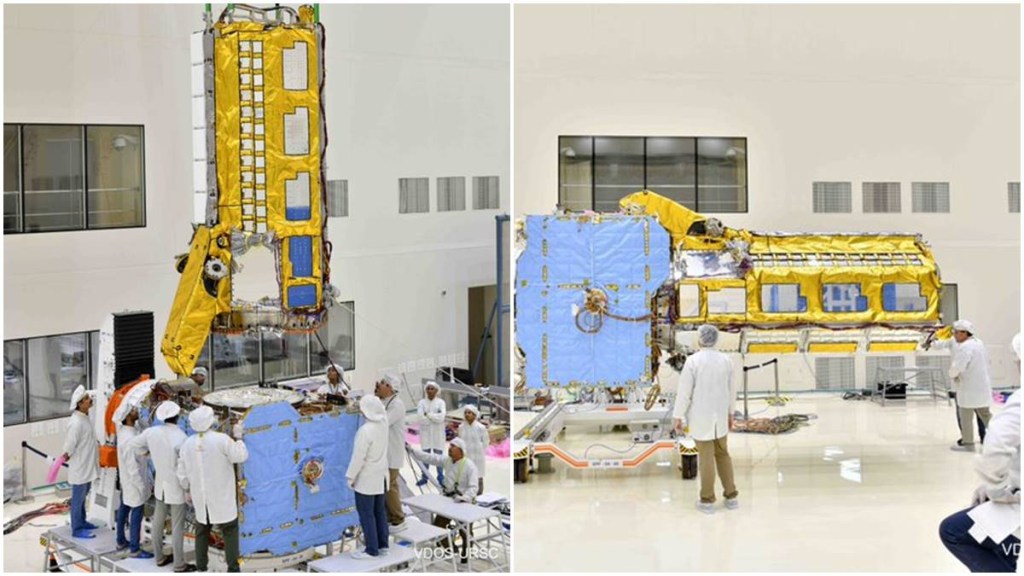In a groundbreaking endeavor, the NISAR satellite is taking shape in Bengaluru, India, as NASA and ISRO combine their expertise to create a powerful spacecraft. Scheduled for launch in early 2024, the NISAR (NASA-ISRO Synthetic Aperture Radar) mission aims to revolutionize our understanding of Earth’s land and ice surfaces with unparalleled precision. By monitoring every corner of our planet at least once every 12 days, NISAR will unlock insights into dynamic ecosystems such as forests, wetlands, and agricultural lands.
An Epic Convergence: NISAR’s Fusion Unveiled
Within an ISRO clean room, the NISAR satellite’s radar instrument payload and spacecraft bus merge, symbolizing a union of cutting-edge technology. Encased in gold-colored thermal blanketing, the payload showcases its cylindrical form, harboring two radar systems. The S-band radar will provide crucial insights into crop structure and land/ice roughness, while the L-band instrument delves into dense forest canopies to study the intricate trunks of trees. With wavelengths measuring approximately 4 inches (10 centimeters) and 10 inches (25 centimeters) for S-band and L-band respectively, these sensors possess the extraordinary ability to gather data day and night, transcending clouds that hinder other observations.
A Journey of Collaboration and Innovation
The payload’s extraordinary voyage has been nothing short of remarkable. First, the S-band radar, created at the Space Applications Centre in Ahmedabad, India, embarked on a voyage to NASA’s Jet Propulsion Laboratory (JPL) in Southern California. There, alongside the L-band radar developed by JPL engineers, the two systems were integrated into the payload’s sturdy framework. Following this pivotal moment, the journey continued as the payload made its way to the U R Rao Satellite Centre (URSC) in Bengaluru, where skilled engineers and technicians worked in tandem with JPL teams to bring the spacecraft’s main body, known as the “bus,” to life. Covered in protective blue blanketing, the bus incorporates components and systems hailing from both ISRO and JPL, playing a vital role in powering, navigating, controlling, and communicating during the mission.
The Grand Reunion: Assembling NISAR’s Core
In a URSC clean room, NASA and ISRO teams have diligently interwoven thousands of feet of cabling between the radar payload and bus. The satellite’s solar panels await attachment, while the drum-shaped, wire-mesh reflector stands ready to unfold gracefully from a 30-foot (9-meter) boom. The reflector, spanning nearly 40 feet (12 meters) in diameter, will become the largest radar antenna of its kind to venture into space.
An Odyssey of Preparation: Journey to the Stars
Presently, the NISAR satellite undergoes rigorous performance testing, followed by a series of environmental assessments to ensure its resilience to the formidable challenges of space. Upon passing these arduous tests, the spacecraft will embark on a 220-mile (350-kilometer) journey to the Satish Dhawan Space Centre. There, it will be poised atop ISRO’s Geosynchronous Satellite Launch Vehicle Mark II rocket, and set forth on its voyage to Low Earth Orbit (LEO).
The Dawn of a Revolutionary Partnership
NISAR stands as an unprecedented testament to the collaborative synergy between NASA and ISRO. This remarkable mission represents the first-ever joint hardware development initiative between the two space agencies, uniting their talents to uncover the secrets of our planet. According to an official NASA statement, while JPL, managed by Caltech for NASA, leads the US component, providing the mission’s L-band SAR and other essential contributions, NASA and URSC contribute additional vital elements, including the radar reflector antenna, deployable boom, communication subsystem, GPS receivers, solid-state recorder, payload data subsystem, spacecraft bus, S-band SAR electronics, and the launch vehicle. Together, they compose the symphony of innovation that will propel NISAR toward unprecedented scientific achievements.
Artemis Accord
In an effort towards strengthening space cooperation, India and the United States have recently inked the groundbreaking Artemis Accord. This landmark agreement signifies a significant boost to the collaborative efforts between the two nations in the realm of space exploration. The Artemis Accord solidifies their shared commitment to advancing scientific discovery, sustainable lunar exploration, and future crewed missions to the Moon and beyond. By joining forces under this historic accord, India and the US pave the way for enhanced knowledge exchange, technological advancements, and joint endeavors that will shape the future of space exploration for generations to come.

